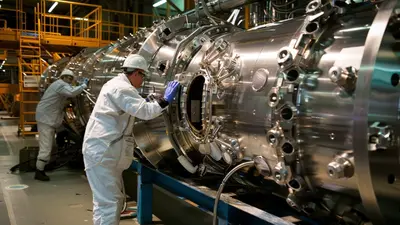
Element 115 (Moscovium) and Bob Lazar
In a groundbreaking collaboration between Russian and American scientists, a new element known as Moscovium was discovered, forever changing our understanding of the periodic table. This discovery, made in 2003, is a remarkable story of scientific ingenuity and international teamwork.
A Team Effort in Discovery
The quest to discover element 115, now known as Moscovium, took place at the Joint Institute for Nuclear Research (JINR) in Dubna, Russia. Here, scientists from both Russia and the United States worked together, using advanced technology and a bit of scientific magic. Their goal was ambitious: to create an element that doesn't exist naturally on Earth.

To create Moscovium, scientists used a powerful machine called a particle accelerator. This machine is capable of propelling atoms at incredibly high speeds. In this case, the team took calcium atoms, which have 20 protons, and smashed them into americium atoms, which have 95 protons. When these atoms collided, they briefly formed a new atom with 115 protons. This fleeting new atom was element 115, Moscovium.
Moscovium is a superheavy element, and it's highly unstable. It only exists for a very short time before breaking down into lighter elements through radioactive decay. Despite its brief existence, the discovery of Moscovium provided valuable insights into the nature of atoms and the forces that hold them together.

Honoring Moscow
The name "Moscovium" was chosen to honor the Moscow region, home to the Joint Institute for Nuclear Research. Officially adopted in 2016, the name celebrates the hard work and dedication of scientists from around the world who made this discovery possible.
Ununpentium was the temporary name for element 115 before it was officially named Moscovium. "Ununpentium" comes from the Latin and Greek roots for the digits of its atomic number, 115 (one-one-five). This placeholder name was used following the IUPAC (International Union of Pure and Applied Chemistry) convention for naming new elements until a permanent name is decided upon.
Connection to Bob Lazar
Bob Lazar, a controversial figure in UFO conspiracy theories, claimed in the late 1980s that element 115, which he referred to as ununpentium, was used as fuel for alien spacecraft. He suggested that this element had unique properties that could bend gravity and power advanced technology. At the time of his claims, element 115 had not yet been discovered, and his statements were met with skepticism. When Moscovium was officially discovered in 2003, it did not exhibit the extraordinary properties Lazar described, making it clear that his claims were not based on scientific evidence.
While Bob Lazar's prediction of element 115 might seem remarkable at first glance, it's important to note that his claim was not based on any groundbreaking insight or discovery. Element 115 was simply the next in line on the periodic table, making its eventual discovery by scientists a matter of time and advanced technology. The periodic table follows a predictable order, so predicting the existence of element 115 didn't require any special knowledge or foresight. When Moscovium was eventually synthesized in 2003, it followed the expected scientific process.

Why Moscovium Matters
Although Moscovium exists for just a fraction of a second, its discovery is significant. Studying Moscovium and other superheavy elements helps scientists push the boundaries of the periodic table and understand more about the universe. Each tiny bit of information gathered from these elements can lead to new scientific breakthroughs and possibly even new technologies.
Recommended

